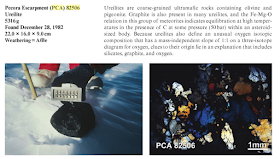I remember after my uncle Richard died, his expedition to Antarctica came up again and again in stories - and I knew he was really into meteorites, I saw his personal collection proudly displayed on the mantle in his study. I started to wonder if any of the meteorites in the national collection were from the same location he went to, or could even be from his expedition.
The next time I found myself in the museum, I took photos of meteorites labeled "Antarctica" so that I could go back and look them up later. There were quite a few! It turns out the stark climate, high contrast of ice to rock, and the flow of ice depositing meteorites up against rocky outcrops all make it the perfect location to find literally more meteorites than could be collected accurately, and that they would leave "hundreds" for future expeditions rather than hastily grabbing them without good records.
So here are my questions and how I found the answers:
- What expedition was my uncle Richard on in Antarctica?
- Which meteorites in the photos include dates that overlap with when my uncle was there?
- Can the specimen be tied to a his specific field season and location?
I found uncle Richard's field season easily enough with a good Google search, which led me to an excerpt from the book Meteorites, Ice, and Antarctica: A Personal Account by William A. Cassidy:
 |
| List of 1982-1983 ANSMET field season participants includes my uncle Richard |
My next puzzle is the date on the museum placard, which simply says 1982, so does that mean the 1981-1982 field season or the 1982-1983 field season? I found a clue searching for "Pecora Escarpment 82506" the actual name of meteorite, and found a report that said the first time the Pecora Escarpment was searched for meteorites was the 1982-1983 season, meaning PCA 82506 couldn't have been found in the 1981-1982 season.
 |
| My photo of "PCA 82506" from the collection at the Natural History Museum in Washington DC |
 |
| Field and Laboratory Investigations of Meteorites from Victoria Land and the Thiel Mountains Region, Antarctica, 1982-1983 and 1983-1984 DOI: https://dx.doi.org/10.5479/si.00810274.28.1 |
 |
| Righter, K., Corrigan, C., McCoy, T., & Harvey, R. (Eds.). (2014). 35 seasons of US Antarctic meteorites (1976-2010): a pictorial guide to the collection. John Wiley & Sons. |
Isn't the internet amazing?!? I was able to find all this from my home computer, linking my late uncle to Antarctica, and to my casual visit to the museum.

No comments:
Post a Comment